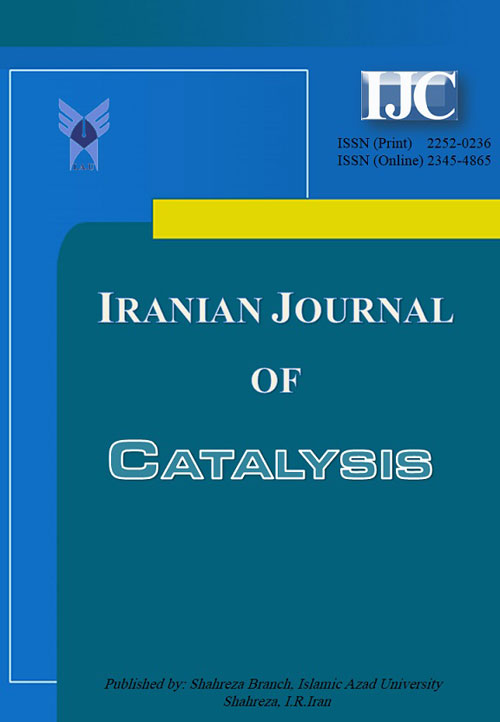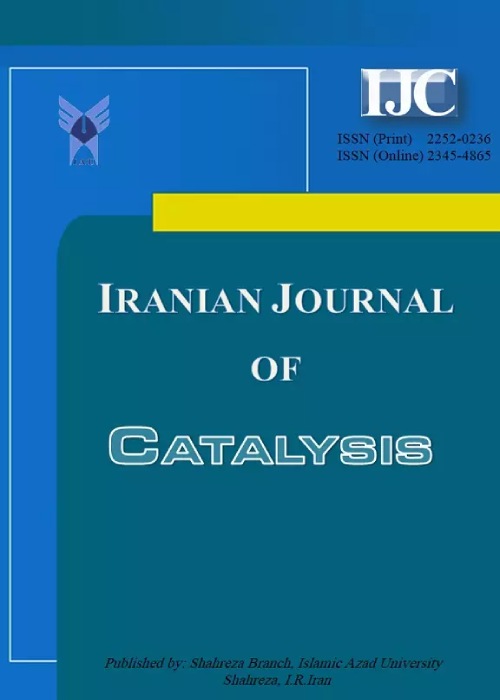فهرست مطالب

Iranian Journal of Catalysis
Volume:9 Issue: 4, Autumn 2019
- تاریخ انتشار: 1398/09/10
- تعداد عناوین: 10
-
-
Pages 273-280Using hydrothermal synthesis process a series of Mobil Five (MFI) zeolites were synthesized with silica to alumina ratio (SAR) of 50, 100 and 200. The synthesized MFI zeolites were used to exchange with 0.5%, 1.0% and 2.0% Ca(NO3)2 solutions for modification of MFI zeolites to Ca-MFI zeolite. The formation of MFI zeolite phases was identified by XRD and FT-IR analysis. TGA studies reveal the thermal stability of the synthesized samples. The successful exchange of the parent samples with Ca was confirmed by UV-Vis (DR) spectra. The specific surface area, pore volume and pore size of the synthesized samples were investigated by the nitrogen adsorption-desorption isotherm. The morphology of the synthesized samples was examined using the scanning electron microscopy. O-methylation of phenol was carried over different synthesized catalysts to produce anisole as the major product.Keywords: MFI, Calcium, Ion-exchange, Microporous, Anisole
-
Pages 281-292Synthesis of nickel oxide nanoparticles (NiO NPs) was carried out by Marrubium astranicum leaf extract. The average of particle sizes for NiO NPs was 40 nm. NiO NPs modified carbon paste electrodes in the absence (CPE/NiO NPs) and the presence of sodium dodecyl sulfate (CPE/NiO NPs/SDS) were examined for the electrocatalytic oxidation of methanol in alkaline solutions. The cyclic voltammograms of modified electrodes showed the redox behavior of Ni(III)/Ni(II) couple. However, the presence of SDS at the surface of the electrode increased the efficiency of the catalyst. The values of charge transfer coefficients (α) for the CPE/NiO NPs and CPE/NiO NPs/SDS in the presence of methanol were estimated at about 0.63 and 0.84. Finally, the electrocatalytic oxidation of methanol at the surface of the CPE/NiO NPs/SDS was studied in the optimum conditions (30 min for immersion time in SDS solution, 0.01 M for SDS concentration and 0.4 M for methanol concentration).Keywords: Methanol, Electrocatalytic, Nickel oxide, Nanoparticle, Modified electrode
-
Pages 293-303In this work, the SBA-15-supported dithizone-copper(I) [SBA-15-dtz–Cu(I)] complex as a new heterogeneous catalyst is prepared for the first time. The catalyst prepared is characterized by the FT-IR spectroscopy, SEM, and ICP techniques. This reusable heterogeneous catalyst can be used in the click reactions for the green and facile synthesis of 1,4-disubstituted 1,2,3-triazolesvia a one-pot three-component reaction of benzyl chloride derivatives, terminal alkynes, and sodium azide in the water at 60 °C. A synthetic technique offering numerous advantages including environmentally friendly, high-to-excellent reaction yields, operational simplicity, short reaction times, reusability of the catalyst, and lack of an organic solvent was developed.Keywords: 1, 2, 3-Triazol, Heterogeneous catalyst, Click reaction, Terminal alkyne
-
Pages 305-320In-situ synthesis of Ti-incorporated MCM-41 nano catalyst was carried out by the hydrothermal method to prepare a mesoporous catalyst for the oxidative desulfurization reaction (ODS). Oxidative reaction of dibenzothiophene (DBT) as a heavy sulfur compound was evaluated in a solution of n-decane as a model of liquid fuel. The synthesized catalysts were characterized by XRD, FESEM, EDX, TEM, FTIR and BET analysis and the most crystalized and purified catalyst on the base of XRD analysis was obtained at the synthesis temperature of 383 K, TIPT/TEOS=0.01, NaOH/TEOS=0.3 and TEOS/CTAB=0.2. The ODS reaction was investigated in a batch reactor in the presence of H2O2 as oxidant and the effect of operating conditions such as reaction temperature and molar ratio of oxidant/DBT were studied by the experimental design and the optimal operating conditions were predicted on the base of maximum DBT conversion. Removal of the produced sulfones was performed by acetonitrile as a polar solvent with the equal volume ratio of acetonitrile to model fuel. By simultaneous reaction and extraction, the DBT removal was achieved up to 99.5% during 20 min reaction. The recyclability of the prepared catalyst was studied by treatment with methanol and drying at 373 K for 4 hours. It was revealed that after two stages of reaction-regeneration, the conversion of DBT was reduced from 99.5 to 88%.Keywords: Oxidative desulfurization (ODS), Hydrothermal synthesis, Mesoporou scatalyst, Titanosilicate, DBT conversion
-
Pages 321-328
Nano-cellulose with high amount of free OH groups could be used as supporting agents for boron trifluoride (BF3). Nano-BF3/cellulose is a solid acid and a biodegradable catalyst which was prepared via reaction of nano-cellulose and BF3. The structure of this catalyst was studied by FT-IR, FESEM, TEM, XRD, EDS, TGA, XRF and BET. In this research, the synthesis of highly functionalized tetrahydropyridines has been developed via a five-component reaction of aldehyde, amine and ethyl acetoacetate using nano-BF3/cellulose under solvent-free conditions. The structures of obtained products were identified by FTIR, 1H NMR and 13C NMR. Some advantages of this protocol are high to good yields, environmentally benign procedure, easy work-up of reaction and moderate reusability of the catalyst.
Keywords: Multicomponent reactions, Tetrahydropyridines, Nano-BF3, cellulose, Solid acid -
Pages 329-337The preparation, characterization, and immobilization of cobalt (III) salen complex on CoFe2O4@SiO2 nanoparticle (CoFe2O4@SiO2@ Co(III) salen complex) are described. Co(III) salen complex loaded on ferrite cobalt-silica nanoparticle is characterized by TEM, SEM-EDX, VSM and FT-IR analyses. The efficiency of CoFe2O4@SiO2@Co(III) salen complex as a catalyst was carried out in the 3-indolylation reaction of indole with isatin derivatives in the water at 80 . Di-indolyloxindole was achieved with excellent yield (95%), using indole, isatin, and CoFe2O4@SiO2@Co(III) salen complex within 2 h in water as solvent at 80 . Moreover, the recoverability and reusability of CoFe2O4@SiO2@Co(III) salen complex were investigated.Keywords: Co(III) salen complex, Di-indolyloxindole, indole, Cobalt ferrite, Isatin, Multicomponent
-
Pages 339-346Water samples of 0, 50, and 100 nephelometric turbidity units (NTU) spiked with fecal coliforms (107 CFU/ml) were exposed to natural sunshine in 1l quartz glass tubes fitted with rectors’ compound parabolic concentrators CPCS at two forms CPC1 (whit nanoparticle zinc oxide) and CPC2(without nanoparticle zinc oxide). The samples were characterized using the X-ray powder diffraction (XRD), scanning electron microscopy (SEM), and transmission electron microscope (TEM). On clear days, the complete inactivation times (more than 7-log unit reduction in bacterial population) in the systems with CPC1, and CPC2 were 15, and 30 min, respectively. The maximum temperatures obtained in the water samples were 80 for CPC1, and 82 for CPC2. The use of CPC1 with hydroxyl radicals (OH•) production significantly improved the efficiency of the old CPCS technique, since these systems (CPC1-2) shortened the exposure times to solar radiation and also minimized the negative effects of turbidity and also regrowth was zero in the disinfected samples. Due to two simultaneous effects of high temperatures and UV, regrowth in most ways of solar disinfection was not seen in these examples. Overall, this technology has been proved to be a good enhancement method to inactivate microorganisms under real conditions and represents a good alternative technique to drinking water treatment.Keywords: Compound parabolic concentrators (CPCs), Solar disinfection, Nano photocatalyst, Fecal coliforms
-
Pages 347-355
A proper, atom-economical, straightforward one-pot multicomponent synthetic route for the synthesis of benzopyranophenazines has been presented by the reaction of hydroxynaphthoquinone, o-phenylenediamine, benzaldehydes, and malononitrile with crosslinked sulfonated polyacrylamide (Cross-PAA-SO3H) attached to nano-Fe3O4as an efficient heterogeneous solid acid catalyst under ultrasonic irradiations in ethanol. Experimental simplicity, wide range of products, excellent yields in short reaction times and applying the sonochemical methodology as an efficient method and innocuous means of activation in synthetic chemistry for the preparation of medicinally privileged heterocyclic molecules are some of the important features of this method. The present catalytic procedure is extensible to a wide diversity of substrates for the synthesis of a variety-oriented library of benzopyranophenazines.
Keywords: Ultrasonic irradiation, Sulfonated Polyacrylamide, Pyranophenazines, Catalytic activity, Nano-Fe3O4 -
Pages 357-368The performance of LaMnxNi1-xO3±δ perovskite mixed oxides (x = 0, 0.1, 0.3, 0.5, 0.7, 0.9, 1) which were prepared by different methods, the Pechini and sol-gel methods in the oxidation of greenhouse gases, CH4 and CO, has been investigated. All samples were characterized using Fourier transform infrared spectroscopy, X-ray diffraction, scanning electron microscopy and N2 adsorption. The results showed that Pechini samples are more active and stable than the sol-gel samples. The partially substituted Ni samples exhibited higher catalytic performance as compared to the LaMnO3 due to the structural defects. But, the high substitution of Ni gradually deforms the structure to rhombohedra, decreases surface area and reduces the number of active Mn sites. Therefore, the catalytic performance passes through a maximum with respect to Ni content. LaMn0.3Ni0.7O3±δ prepared by the Pechini method is more active than others in the oxidation of CH4 and CO.Keywords: Perovskite mixed oxide, LaMnxNi1-xO3±δ, Greenhouse gas, Methane combustion, CO oxidation
-
Pages 369-374Mohammad Javad Poursharifi was born in 1971 in Ray City, Iran. He obtained his B.Sc. (1994) from Kharazmi University, Tehran. He then completed his M.Sc. studies in Organic Chemistry (2008) from Islamic Azad University, Saveh Branch, Iran. Currently, he is working towards his Ph.D. under the supervision of Professor Mohammad Majid Mojtahedi and Professor Mahmood M. Hashemi at Islamic Azad University, Science and Research Branch. His research involves synthetic applications of 1,3-dioxan-5-one derivatives.Keywords: 1, 3-Dioxan-5-one, Mannich reaction, Diels-Alder cycloaddition, Baylis-Hillman reaction, Claisen-Schmidt condensation, Dihydroxyacetone


